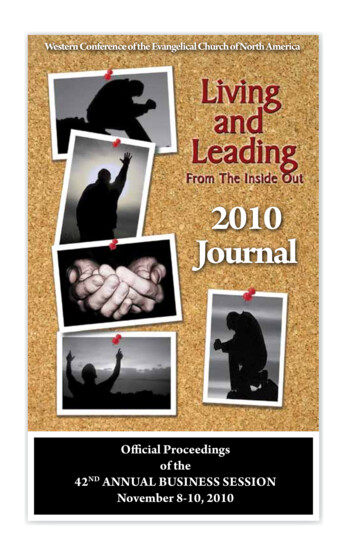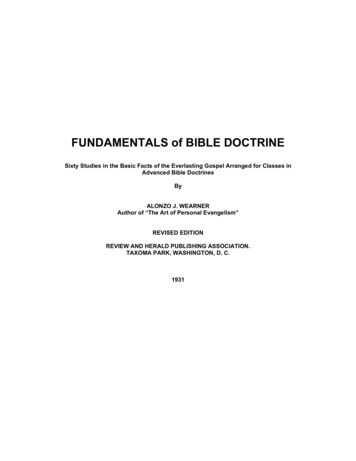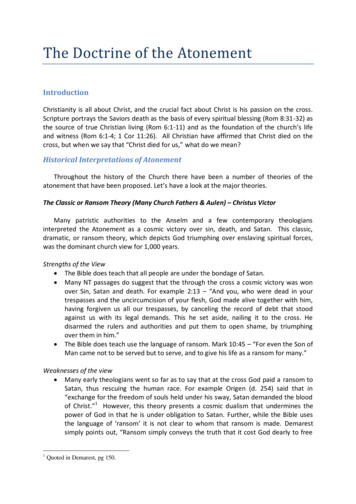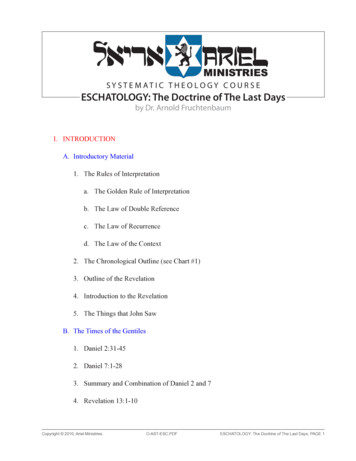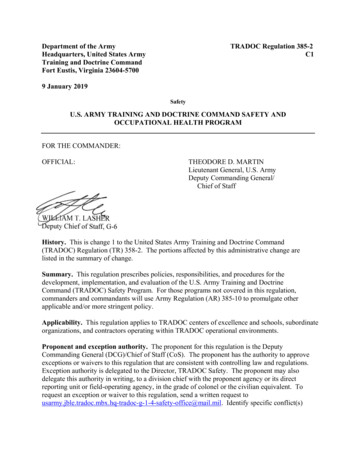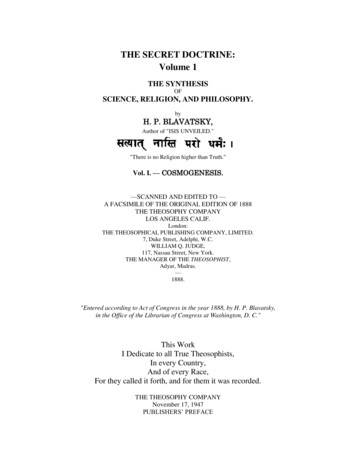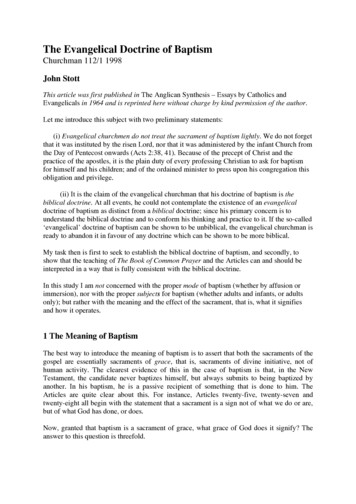
Transcription
The Evangelical Doctrine of BaptismChurchman 112/1 1998John StottThis article was first published in The Anglican Synthesis – Essays by Catholics andEvangelicals in 1964 and is reprinted here without charge by kind permission of the author.Let me introduce this subject with two preliminary statements:(i) Evangelical churchmen do not treat the sacrament of baptism lightly. We do not forgetthat it was instituted by the risen Lord, nor that it was administered by the infant Church fromthe Day of Pentecost onwards (Acts 2:38, 41). Because of the precept of Christ and thepractice of the apostles, it is the plain duty of every professing Christian to ask for baptismfor himself and his children; and of the ordained minister to press upon his congregation thisobligation and privilege.(ii) It is the claim of the evangelical churchman that his doctrine of baptism is thebiblical doctrine. At all events, he could not contemplate the existence of an evangelicaldoctrine of baptism as distinct from a biblical doctrine; since his primary concern is tounderstand the biblical doctrine and to conform his thinking and practice to it. If the so-called‘evangelical’ doctrine of baptism can be shown to be unbiblical, the evangelical churchman isready to abandon it in favour of any doctrine which can be shown to be more biblical.My task then is first to seek to establish the biblical doctrine of baptism, and secondly, toshow that the teaching of The Book of Common Prayer and the Articles can and should beinterpreted in a way that is fully consistent with the biblical doctrine.In this study I am not concerned with the proper mode of baptism (whether by affusion orimmersion), nor with the proper subjects for baptism (whether adults and infants, or adultsonly); but rather with the meaning and the effect of the sacrament, that is, what it signifiesand how it operates.1 The Meaning of BaptismThe best way to introduce the meaning of baptism is to assert that both the sacraments of thegospel are essentially sacraments of grace, that is, sacraments of divine initiative, not ofhuman activity. The clearest evidence of this in the case of baptism is that, in the NewTestament, the candidate never baptizes himself, but always submits to being baptized byanother. In his baptism, he is a passive recipient of something that is done to him. TheArticles are quite clear about this. For instance, Articles twenty-five, twenty-seven andtwenty-eight all begin with the statement that a sacrament is a sign not of what we do or are,but of what God has done, or does.Now, granted that baptism is a sacrament of grace, what grace of God does it signify? Theanswer to this question is threefold.
a) Baptism signifies union with ChristGod’s chief grace to undeserving sinners is his plan to unite them to his Son. That this is theprimary meaning of baptism is clear from the use of the preposition eis with the verb ‘tobaptize’. Just as the passage of the Red Sea was a baptism eis (into) Moses (1 Cor 10:2), soChristian baptism is baptism not into any man (1 Cor 1:13) but into Christ (Rom 6:3). It istrue that sometimes baptism is said to be en or epi the name of Christ (Acts 10:48; 2:38), butthe commonest preposition is eis, ‘into the Name of the Lord Jesus’ (Acts 8:16; 19:5).It is true again that, according to the Matthaean record of the institution of baptism, baptismwas to be into the one Name of the three Persons of the Trinity (Matt 28:19), but this givesplace in Acts and the Epistles to baptism into the Name of Jesus – probably because it is hewho revealed the Father and sent the Holy Spirit, so that we cannot be related to him withoutbeing related to them also.Further, baptism into the Name of Christ is baptism into Christ crucified and risen (Rom 6:3,4). This union with Christ crucified and risen signifies participation in the virtue of his deathand the power of his resurrection, the end (by death or burial) of the old life of sin, and thebeginning (by resurrection or rebirth) of the new life of righteousness. This union with Christin his death and resurrection, and the beginning of a new life, is the controlling idea inbaptism, and the next two meanings simply amplify the benefit of sharing in the death andresurrection of Christ.b) Baptism signifies the forgiveness of sinsIt is safe to say that all religious water rituals are purification ceremonies, and Christianbaptism is no exception. ‘Repent and be baptized every one of you in the name of JesusChrist for the forgiveness of your sins’, said Peter on the Day of Pentecost (Acts 2:38). ‘Rise,and be baptized, and wash away your sins, calling on his Name’, said Ananias to Paul (Acts22:16). Similarly, it is almost certain that the phrases ‘but you were washed’ (1 Cor 6:1l), and‘the washing of regeneration’ (Titus 3:5) are references to baptism. The washing of ourbodies with pure water (Heb 10:22) signifies the washing of the soul from the defilement ofsin.c) Baptism signifies the gift of the SpiritIt is well known that John the Baptist (according to the four evangelists) contrasted his ownwater-baptism with the Spirit-baptism which the Messiah would administer: ‘I baptize youwith water. He will baptize you with the Holy Spirit’ (Matt 3:11). In view of this contrast,we would expect that when Jesus Christ began to baptize with the Spirit, all baptism withwater would cease. The fact that water-baptism continued, by special command of the risenChrist, suggests that it now intended to signify the very Spirit-baptism with which it hadpreviously been contrasted. The pouring of water by which we receive the baptism of water,dramatizes the outpouring of the Spirit by which we receive the baptism of the Spirit. Peterseems to have understood this on the Day of Pentecost, for, having interpreted the coming ofthe Spirit as the fulfillment of God’s promise to pour out his Spirit on all flesh, he said:‘Repent and be baptized every one of you in the name of Jesus Christ for the forgiveness ofyour sins; and you shall receive the gift of the Holy Spirit. For the promise is to you and to
your children and to all that are far off, every one whom the Lord our God calls to him’ (Acts2:38, 39). Here baptism is associated with both the forgiveness of sins and the gift of theSpirit.These two blessings were distinctive blessings of the New Covenant promised by Godthrough the prophets. Baptism is therefore to be understood as an eschatological sacrament,inasmuch as it initiates into the New Covenant which belongs to the New Age. It does this byincorporating us into Christ, for Jesus Christ is the mediator of the New Covenant, and thebestower of its blessings.To sum up, baptism signifies union with Jesus Christ in his death and resurrection, involvingthe end of the old life (through the forgiveness of sins) and the beginning of a new life(through the gift of the Spirit). Alternatively, baptism signifies union with Christ bringingboth justification (a once for all cleansing and acceptance) and regeneration (a new birth bythe Spirit unto a life of righteousness). To these three meanings of baptism we must add thatincorporation into Christ includes incorporation into the Body of Christ, the Church.With all this The Book of Common Prayer is fully consistent.(i) Union with Christ. In the Catechism, the second answer declares that in baptism ‘I wasmade a member of Christ’. This is the controlling idea – incorporation into Christ. Such aunion with Christ involves ‘a death unto sin and a new birth unto righteousness’ throughbecoming partakers of Christ’s death and resurrection.(ii) Forgiveness. Familiar expressions in the Baptism Service are ‘the everlastingbenediction of thy heavenly washing’, and ‘the mystical washing away of sin’.(iii) The Gift of the Spirit. ‘Regeneration by thy Holy Spirit’ is the gift signified in baptismfor which we give thanks.These two blessings are brought together in Article twenty-seven: ‘the promises of theforgiveness of sins and of our adoption to be the sons of God by the Holy Ghost are visiblysigned and sealed’.(iv) Church membership. The service speaks of a reception, grafting, or incorporation intoChrist’s holy Church, or the congregation of Christ’s flock.We turn now from the meaning of baptism to its effect; from what it signifies to how itoperates.2 The Effect of BaptismWe would all (I imagine) agree with the definition of a Sacrament given in the Catechism:‘an outward and visible sign of an inward and spiritual grace given unto us, as a meanswhereby we receive the same, and a pledge to assure us thereof’.So far we have been seeking to define the inward and spiritual grace of which baptism is theoutward and visible sign. We now go on to define the relation between the visible sacramentand the invisible grace, between the sign and the thing signified, and thus to define the effect
or operation of the sacrament.Three main views have been held. The first is the view that the sign always conveys the gift,automatically, by itself, ex opere operato, so that all those who receive the sign willy-nillyalso receive the thing signified.The second is the view (at the opposite extreme) that the sign effects precisely nothing. Itsignifies the gift visibly, but in no sense or circumstance conveys it. It is a bare token orsymbol, and that is all. Neither of these is the evangelical doctrine of baptism.The third and evangelical view is that the sign not only signifies the gift, but seals or pledgesit, and pledges it in such a way as to convey not indeed the gift itself, but a title to the gift –the baptized person receiving the gift (thus pledged to him) by faith, which may be before,during or after the administration of the sacrament.The best way to proceed will be to examine these three views consecutively – the ex opereoperato view, the bare token view, and the covenant sign view.(i) The ex opere operato view. This is the view that the sign always, inevitably andunconditionally conveys the thing signified, through the power of the sacrament itself, or ofGod’s promise attached to the sacrament. The consequence of this view is to suppose that allbaptized persons (especially infants) are regenerate.Apart from the pragmatic argument that all baptized persons do not seem to be regenerate,for they do not supply evidence of their regeneration in a life of godliness and holiness, thereare two strong biblical arguments against this view. They concern the nature of the Church,and the way of salvation.a) The nature of the Church. However unfashionable it may be today, the Bible doesenvisage a difference between the visible and the invisible Church. We do not mean by thisthat a person can belong to the invisible Church without responsible membership of a local,visible manifestation of it, but rather that it is possible to belong to a visible church withoutbelonging to the true Church, the Body of Christ, which is invisible in the sense that itsmembers are known to God alone (2 Tim 2:19).As St Augustine wrote: ‘Many of those within are without; and some of those without arewithin’. Again, Bishop John Pearson, in his famous An Exposition of the Creed wrote: ‘Iconclude therefore, as the ancient Catholicks did against the Donatists, that within theChurch, in the public profession and external communion thereof, are contained persons trulygood and sanctified, and hereafter saved, and together with them other persons void of allsaving grace, and hereafter to be damned.’Thus, St John writes of certain heretics that ‘they went out from us, but they were not of us.’(1 John 2:19). They were members (doubtless baptized members), but though ‘with us’outwardly and visibly, they were not ‘of us’, not genuine, but spurious.Similarly, Paul writes at the beginning of 1 Corinthians 10 of the Old Testament Church inthe wilderness ‘that our fathers were all. baptized into Moses in the cloud and in the sea, andall ate the same supernatural food and all drank the same supernatural drink. Neverthelesswith most of them God was not pleased; for they were overthrown in the wilderness.’ The
apostle deliberately describes them as baptized communicants, who nevertheless wereoverthrown in the wilderness; which shows that baptized communicant membership of thechurch is no guarantee of salvation.The significance of this distinction between the visible and the invisible Church is that thevisible Church consists of the baptized, while the invisible Church consists of the regenerate.Since the two companies are not identical, not all the baptized are regenerate.Simon Magus is an example. He professed faith, was baptized, and no doubt passed as achurch member, but Peter described him as being yet ‘in the gall of bitterness and in the bondof iniquity’, with his ‘heart not right in the sight of God’ (Acts 8: 13-24).If Paul could write ‘he is not a real Jew who is one outwardly, nor is true circumcisionsomething external and physical. He is a Jew who is one inwardly, and real circumcision is amatter of the heart, spiritual and not literal’, we could say the same of the Christian andbaptism (Rom 2:28, 29).b) The way of salvation. Salvation is variously described in the New Testament, but wehave already seen that two of its constituent parts are Justification and Regeneration. One is alegal, the other a biological metaphor, but they are two sides of the same coin. It isimpossible to be regenerate without being justified.Over and over again the New Testament writers declare that we are justified by faith, or(more accurately) by grace through faith. It is impossible to reconcile this doctrine with theview that justification is by grace through baptism, with or without faith. If faith is necessaryfor salvation, then the unbelieving candidate is not saved through baptism. What Paul writesin Romans 6 about being baptized into Christ must not be interpreted in such a way that itcontradicts his teaching in chapters three to five of the same epistle, that we are justified byfaith.Va
John Stott This article was first published in The Anglican Synthesis – Essays by Catholics and Evangelicals in 1964 and is reprinted here without charge by kind permission of the author. Let me introduce this subject with two preliminary statements: (i) Evangelical churchmen do not treat the sacrament of baptism lightly. We do not forget


